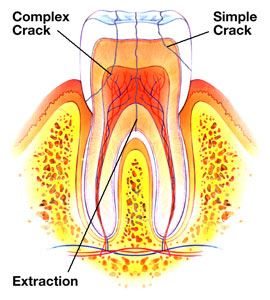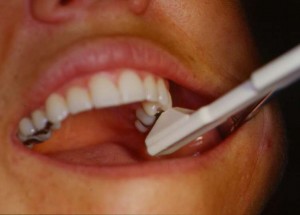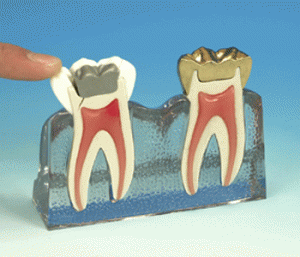Sometimes you feel a sharp tooth pain upon biting and it causes you much annoyance and agony. There are many reasons for pain on biting and a cracked tooth is one of them.
 Why do teeth crack?
A crack in the tooth is a possible cause suggested by pain on biting. It is triggered by tooth-tooth contact. Fillings placed in our mouth, though meant to restore our teeth, can also weaken them, and the risk of cracking depends on the size of the restorations. A large restoration is more likely to crack as more tooth structure is missing.
 Intact teeth can also crack, though usually only in association with increased occlusal load. The presence of enlarged muscles of mastication especially the masseter muscle and wearing down of the chewing surfaces of the teeth would suggest a parafunctional habit that could predispose the tooth to cracking.
 Root-filled teeth after root canal therapy are also prone to crack but obviously could not cause pulpal pain. Symptoms would then only be produced if the periodontal ligament were involved and the pain would be well-localized.
What are the symptoms and signs of a cracked tooth?
- Symptoms – sharp pain on biting for a short duration
- Signs – often relatively few, therefore diagnosis is difficult. Tooth often has a large restoration. Crack may not be apparent at first but transillumination and possible removal of the restoration may aid visualization. May be associated with bruxing habit.
How is the causative tooth identified?
-
Investigations including tests of vitality of all teeth in the quadrant involved are performed, either with an electric pulp tester or a cold stimulus – the pain must originate from a vital tooth. it is also possible that the cracked tooth might be hypersensitive. Vitality might also affect the choice of treatment.
-
Close examinations with a good light (a bright fiber optic is especially useful for transillumination). A soluble dye such as a disclosing agent may be painted onto the crown. After the excess is washed off small amounts may remain in the crack rendering it visible.
-
Attempts to stimulate the pain by pressing the handle of an instrument against each cusp, preferably from more than one direction. Pain indicates a cracked cusp and the causative cusp is identified.
-
The individual is asked to bite hard on a soft object such as a cotton wool roll – this transmits pressure to the whole chewing surface and forces the cusp slight apart. Pain on biting suggests a dental cracked tooth.
-
A wooden wedge or Tooth Slooth is placed against each cusp in turn and ask the individual to bite on each – this is a more selective test to identify cusp or cusps which are cracked. By placing the wedge on different surfaces of the cusp it may be possible to tell in which direction the crack runs. There may be pain on biting but cracked tooth pain which is worse on release of pressure is said to be characteristic.
-
Radiograph or x-rays are used to exclude possibility of tooth decay and to assess the feasibility of root filling the tooth should be it be necessary. The radiograph is unlikely to be of direct help in diagnosis and might not be necessary if other investigations successfully identify the cracked cusp.
What are the treatment options for cracked teeth?
- No treatment – this is not an option, even if the you are happy to put up with the pain. Cracks may propagate into the pulp, allow bacterial contamination and devitalize the tooth.
- Removal of the cracked portion followed by restoration – this is unsafe. Levering the cracked portion risks a catastrophic fracture with contamination of the pulp. Many cracks are incomplete and leverage may propagate them in unpredictable directions. Just occasionally the fragment will be limited to enamel and dentine of the crown, particularly where the tooth already contains a large restoration undermining the cusp but even then a deliberate fracture is not recommended.
- Full or partial coverage with gold indirect restoration – this is the treatment of choice. Gold is malleable and allows some plastic deformation which is not possible with ceramics or composites which are more brittle. Full occlusal coverage is needed to protect the tooth from further damage and a casting can provide some splinting, reducing the potential for further cracks.
- Full coverage bonded porcelain crown – full coverage with porcelain bonded to metal has the advantage of a better appearance but the ceramic is brittle. This disadvantage may be offset by using an adhesive to lute the crown. There is then the potential for the crack to be sealed by the infiltrating cement.
- Adhesive restoration – in theory an adhesive restoration would cement the crack together and prevent movement of the two fragments. However, on curing adhesive materials undergo polymerization shrinkage which places further stress on the crack and may propagate it further. An adhesive resin composite restoration may be appropriate in teeth which are minimally restored.
- Porcelain inlay/onlay – these suffer the same disadvantages of metal fused to porcelain crowns.
- Occasionally root canal treatment may be required if the crack is minimal and near the pulp.
- A cracked that has propagated to the root is difficult to save especially a vertical split of the tooth and the cracked tooth root may need to be removed.


